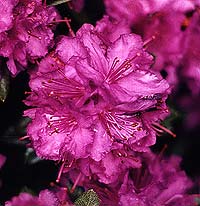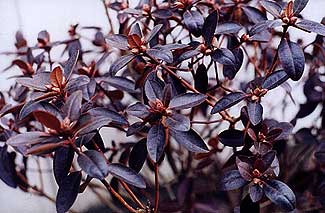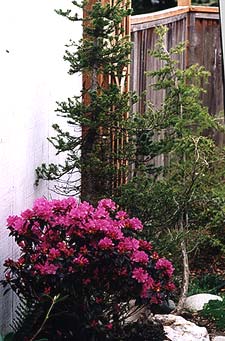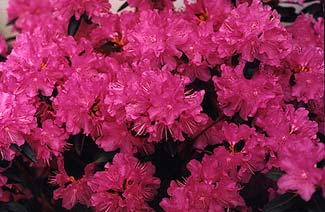 Rhododendron 'PJM Elite,'
Rhododendron 'PJM Elite,'
an early bloomer
"The sound of the water-pot
on the leaves filled father Mabeul's
soul with ecstasy. It seemed to him
that the rhododendron was happy now."
-Victor Hugo,
Les Miserables
Les Miserables
This hybrid between Rhododendron carolinianum & R. dauricum var. sempervirens bears the cultivar name 'PJM Elite.' There are many PJM or "Mezitt" cultivars, of which Elite is one of the deepest pink for blossoms, is latest to bloom of this early-blooming lot, & grows to be the largest.
The initials P.J.M. stand for Peter J. Mezitt, who began the process completed by his son Ed in developing the very first crosses ever to carry those initials. The first field of PJM was developed from 1936 to 1945 in Massachusetts, & Ed Mezitt's bushes have been the basis of many of the most popular cold-hardy varieties ever since. The larger-growing 'PJM Elite' is a later creation from these stocks, introduced to gardening in 1987
 Our little specimen was only three & a half feet tall when planted in 2001. It has needed pruning every year to keep it from growing too wide for the space allotted, & gained a full foot height in two years. The PJMs in general can reach six feet, & ten feet isn't unheard of, with 'PJM Elite' not stopping there.
Our little specimen was only three & a half feet tall when planted in 2001. It has needed pruning every year to keep it from growing too wide for the space allotted, & gained a full foot height in two years. The PJMs in general can reach six feet, & ten feet isn't unheard of, with 'PJM Elite' not stopping there.The majority of the group grow much more slowly so are defacto dwarfs, taking ten years to reach four feet of height & slowing down all the more thereafter, & we frankly didn't realize 'PJM Elite' would be trying to get so much bigger so quickly, forcing us to seasonal prune. It's parent component R. dauricum really was a dwarf, which is why PJMs look mature & can be blooming when only six or eight inches tall.
Like other rhodies it prefers moist cool acidic soil with lots of organic material; however, it is more soil adaptable than most rhodies & will do well in less than ideal conditions. It dislikes windy sites but is otherwise one of the easiest of all rhodies to grow, requiring no babying.
 The third photo here at the right shows our PJM near dwarfed subalpine evergreen trees. Both those trees are local natives brought down from subalpine areas by liscensed tree hunters. The angle is forshortened, so the shrub & two trees look closer than they really are. The slightly taller evergreen is Alpine Fir which adapted splendidly in the garden; they are giants on the mountain heights but grow less than an inch a year at sea level, a defacto dwarf. The slightly shorter tree is a Mountain Hemlock, which one year later died on us. When we dug it out we saw what we hadn't been able to see when it was obtained in "ball & burlap," i.e., the root had been horribly mutilated in the gathering, & it had failed to generate much in the way of new roots. Mountain hemlocks are in the best of circumstances delicate reestablishing at sea level, but this one never had a chance.
The third photo here at the right shows our PJM near dwarfed subalpine evergreen trees. Both those trees are local natives brought down from subalpine areas by liscensed tree hunters. The angle is forshortened, so the shrub & two trees look closer than they really are. The slightly taller evergreen is Alpine Fir which adapted splendidly in the garden; they are giants on the mountain heights but grow less than an inch a year at sea level, a defacto dwarf. The slightly shorter tree is a Mountain Hemlock, which one year later died on us. When we dug it out we saw what we hadn't been able to see when it was obtained in "ball & burlap," i.e., the root had been horribly mutilated in the gathering, & it had failed to generate much in the way of new roots. Mountain hemlocks are in the best of circumstances delicate reestablishing at sea level, but this one never had a chance.I almost didn't plant a PJM merely because they are so common, but there's more than one reason for its popularity. My own desire to have my garden interesting in winter as well as the rest of the year meant I could not long resist a PJM. In the second photograph above, a January portrait, you can see the winter coloration of the evergreen leaves, somewhere between chocolate-brown & mahogony. It also has good autumn color, which is shown on the Autumn Rhodies & Azaleas Garden Walk, PJM Page.
The PJM's winter leaf color fades away in March & is again shiny green by April. It thrives in two-thirds sun or part shade, but here on Puget Sound, really it needs the sun, & gets its best winter mahogony or plum leaf color if it has at least half sunny days. The leaves are aromatic if you crush them, smelling a little bit like sassafrass rootbeer. Rhodies & azaleas are very mildly toxic however, so don't try to make a tea out of these! When the leaves turn back to a shiny green in Spring, last year's leaves retain some dark speckling on the underside. New leaves start out bright pale green in April but quickly harden to dark green.
 It is very cold hardy to minus 25 Fahrenheit, because the R. dauricum component of its genetic make-up is subarctic or high alpine in origin, which is also why it blooms so early; we had a March snowfall when the PJM was already in bloom. PJMs generally do not seed & are propagated through cuttings.
It is very cold hardy to minus 25 Fahrenheit, because the R. dauricum component of its genetic make-up is subarctic or high alpine in origin, which is also why it blooms so early; we had a March snowfall when the PJM was already in bloom. PJMs generally do not seed & are propagated through cuttings. Some of the literature promises it will bloom in late April, but that must mean when planted further North or in much colder regions than we experience. Our PJM has small pale buds just large enough to be decorative by the second week in February; the buds are full-sized early in March with lots & lots of half-open buds showing color by mid-March, & in full stunning bloom before month's end. The flower close-ups at the top & bottom of this page are late March (2001) portraits of the vivid pink blossoms. In 2003, the shrub unexpectedly produced two flowers prematurely, at mid-November, as a few warm days in autumn or winter easily fool the shrub that spring is near.
The wonderful blooms last through all of March until the end of the first week of April, but just before the middle of April, the blooms tumble neatly down like autumn leaves. This self-cleaning habit can be forstalled by a heavy rain, which mats the flowers to the leaves so the shrub has to be cleaned of faded blooms, but most years it takes care of itself. The tidiness of the bloom-fall is another plus for this plant, as some of the rhodies need to have the dead blossoms physically removed or the shrub looks just awful with brown shriveled flowers. The resulting carpet of fallen flower petals (prettily covering the ground between spreading clumps of Alpine Snowbells) is quite a lovely ending for PJM Elite's blooming period.
A few additional photographs of the flowers can be found on the PJM Elite page of the Rhododendron Blooms Gallery.
PJMs are just the best known of late winter or earliest spring bloomers. Another such is our semi-deciduous 'Milestone' Rhododendron which like PJM is a Mezzitt family creation. Its blooms similarly last until the first week of April, then fall off tidily. One of our earliest pf ear;u bloomers is a deciduous Korean Snow Azalea (R. mucronulatum 'Crater's Edge') which blooms at the first whisper of spring, sometimes in January before it has any leaves. R. pachytrichum 'Sesame' is a mid to late February bloomer.